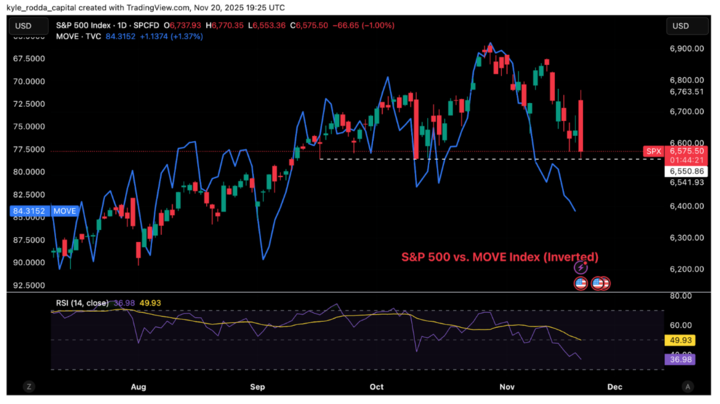Market volatility could persist for as long as US interest rate uncertainty continues
Uncertainty about the path forward for US monetary policy is the critical driver of recent weakness in global equities.
The sell-off in global markets is fundamentally a function of monetary policy uncertainty. There’s definitely a big overlay of tech valuations becoming too stretched amid legitimate concerns about the returns on massive investments in artificial intelligence. But for the most part, this sell-off in equities, Bitcoin and other assets (even including gold) comes because the markets aren’t sure what the US Federal Reserve will do with monetary policy in December and beyond. You can see the dynamic in the relationship between implied volatility in the bond market – itself mostly, though not entirely, a reflection of monetary policy expectations – and US indices. Below, for example, is the MOVE Index (the VIX of the bond market) overlaid onto the S&P 500.

(Source: Trading View)
(Past performance is not a reliable indicator of future results)
It should be considered no coincidence that US equities topped as implied volatility in the bond market bottomed – exactly when Fed Chairperson Jerome Powell warned a December rate cut was “not a foregone conclusion”. The bottom in the MOVE Index and approximate top of the US stock market came at the end of October, around the time of the last Fed decision. Interest rate uncertainty is currently a function of upside inflation risks, with any price data a possible source of further volatility.
The odds of a rate cut in December lifted a bit after last week’s US jobs data. Added to that dovish commentary from the Fed’s John Williams on Friday, the markets have swung from implying a roughly 25% chance of a reduction to 75% in the space of two trading days. Even as the odds of cuts rise, the most important driver of price action is the uncertainty, which is inherently causing the volatility and risk aversion. As a result, it’s unlikely that the volatility in the markets will ease until the uncertainty about US Fed policy subsides – either from reassuring data that signals an all clear for the Fed to keep cutting, or an actual cut being delivered at the December meeting.